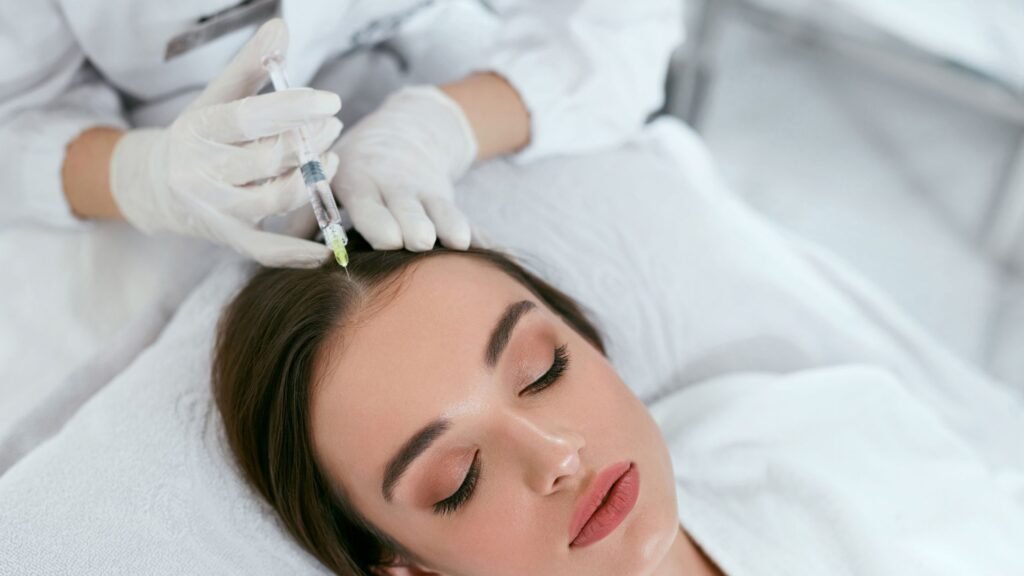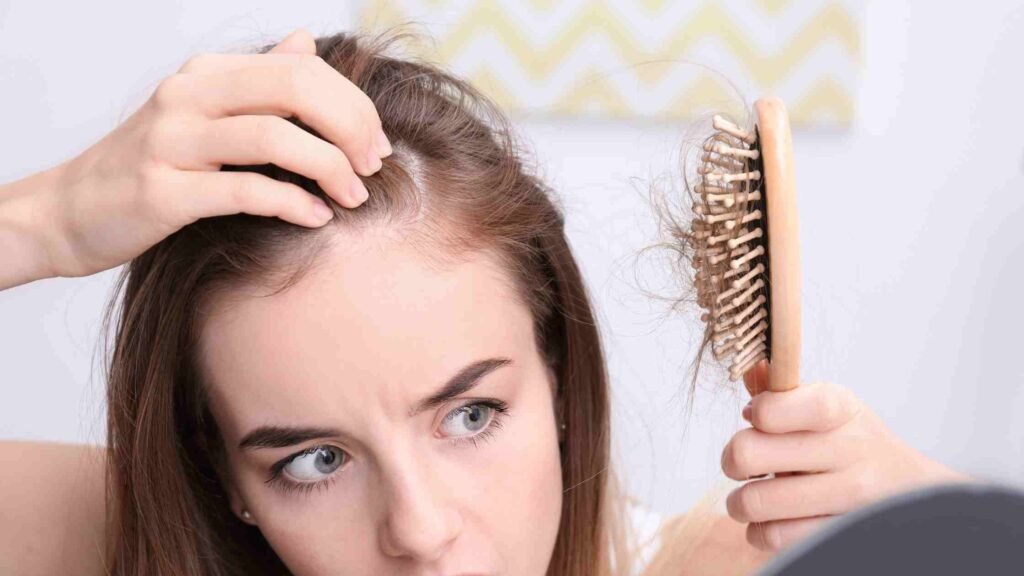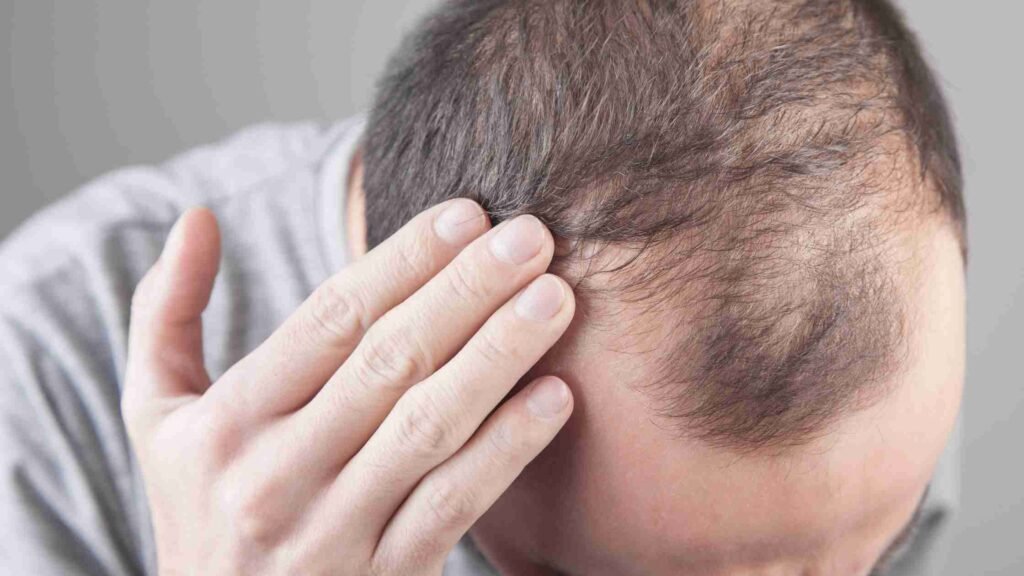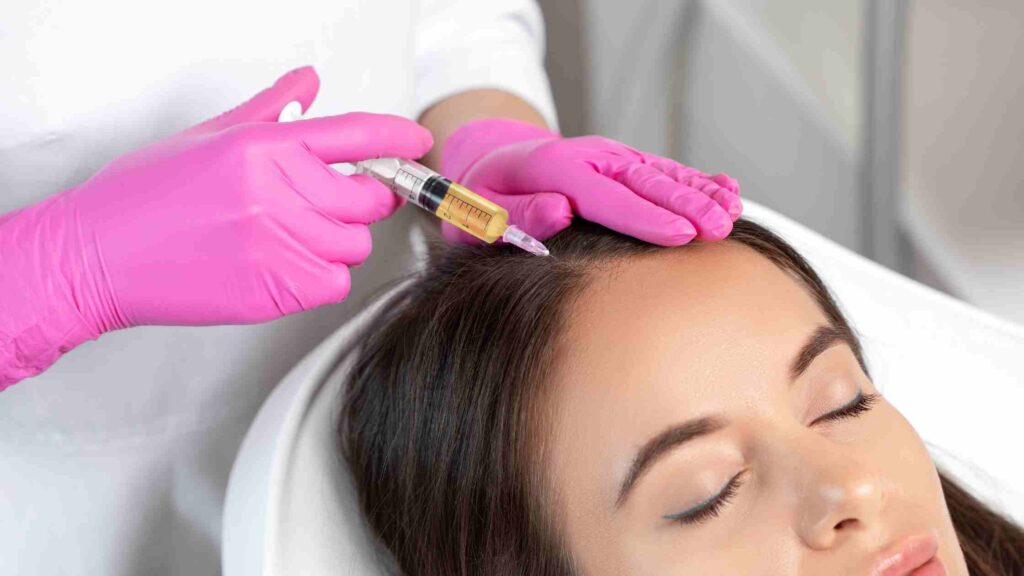Surprisingly we all are born with all the hair follicles we will ever have. And the total number of hair follicles we have on our scalps is as massive as 80,000 to 1,20,000. Though we lose around 100 hair daily, those follicles are intact to facilitate hair regrowth.
Read more about PRP for Hair Loss: Does it Work, and Is It Safe?
The hair growth process is such that it grows from the bottom of a follicle when the blood in the scalp goes through the follicle and supplies necessary oxygen and nutrients to the hair root to help the hair grow. During hair growth, the hair pushes through our skin and passes by an oil gland that makes our hair soft and shiny.

However, the pace of hair growth and the chances of hair regrowth are not equal in every individual. Genetics plays a vital role in hair regrowth and maintaining healthy hair growth alongside other factors that come into play. And that is the reason many people suffer from a problem in which their daily hair fall is usually the same as others or even more, but their hair doesn’t regrow. And when such a discrepancy in hair fall and lack of regrowth is frequent or permanent, it leads to baldness.
Although badness is a universal phenomenon, Indians encounter a unique set of challenges and problems with hair loss. The youth in their early 20s are also reporting to have initial science of hair fall.
This article aims to unfold the most common causes of hair fall in Indians and various hair regrowth treatment options in India to reverse the hair loss process. To demystify the process of hair fall and to understand the stages of development of human hair, read this article till the end.
The Composition And Structure Of Human Hair
As discussed earlier, our hair grows out of the follicles located beneath our scalp between the deep layers of the dermis and the hypodermis. In many places in this article, we might address those follicles as hair bulbs.
For hair growth, a small vessel passes through the inside of the hair shaft to provide required blood flow and vital elements such as amino acids, vitamins, and mineral salts to help the hair remain healthy.
Different glands surround the hair shaft, most notably the sebaceous gland that produces sebum that acts like a lubricant for the hair. On the surface of our scalp, there are pores to evacuate the sweat produced by the sweat glands.
Read more about How to Treat Temple Hair Loss
Our hair is made of 95% keratin, a fibrous helicoidal protein with a shape like a helix that also forms body hair and nails. Since keratin is insoluble in water and is synthesized by keratinocytes, our hair is impermeable and protected. Keratin is also rich in cysteine, forming disulfide bonds between molecules to add resistance and rigidity to our hair’s structure. Apart from keratin, more than 18 amino acids are present in our hair, including proline, arginine, leucine, and more.
We can divide the structure of our hair into three distinct parts:
- Medulla- the innermost layer of the hair composed of amorphous, soft, and oily substances.
- Cuticle- the second thin protective layer which is highly keratinized, composed of cells, and has all the nourishing potions essential for hair growth.
- Cortex- the outermost component of our hair made of keratin chains and is responsible for adding suppleness, elasticity, and resistance to our hair.
Read more about Best Non-Surgical Treatments for Hair Loss
Why Does Hair Fall Occur?
Hair is the crowning glory, and everyone desires a head full of hair. By now, we already know the composition and structure of human hair, especially the components contributing to the rigidity and shine of our her.
But the question is, even after the presence of all those essential elements, why does our hair fall or thin?
Hair fall leads to low self-image and self-esteem. And when it happens in youngsters, they feel low in confidence and start using camouflaging methods to hide hair loss. And all the behavioral changes that arrive with excessive hair loss prove that hair loss affects a person mentally and emotionally.
Hair fall and hair damage are quite disturbing problems, and those issues are commonly identified after hair wash or combing. And the problem of hair deterioration is identified as tangled hair in the teeth of your comb, frizzy hair after wash, and when some hair follicles don’t grow.

The Most Common Causes Of Hair Fall Are:
Stress
Emotional stress is more likely to cause hair fall than physical stress. Many people who experience cases like the death of loved ones, aging parents, or relationship issues also face excessive hair loss.
Read more about How to Stop & Control Hair Fall with PRP Treatment?
Nutrition Deficiency
Nutrition deficiency probably should top the list of causes of hair fall. If you lack essential nutrients such as vitamin B, you will likely experience heavy hair fall. When an individual does not take care of the nutrients in their diet and stays away from foods that promote hair growth, such as lean proteins, fruits, and vegetables, they can experience hair loss.
Lack Of Proteins
Protein deficiency is the contributing factor to hair fall. If you don’t add enough protein to your diet, more protein breakdown will occur in your body. And this will deplete your hair with the necessary protein it requires to grow and stop the inflow of keratin into the hair.
Using Wrong Products
Using incorrect hair products is also a common reason for hair fall. Therefore, good quality products are always recommended to maintain hair health and reduce hair fall. When you face any problem such as hair fall or dandruff, rather than fixing the problem superficially, focus on using formulated hair care products that can resolve the problem from the root in a targeted manner.
Genetics
Genetics plays a vital role in hair fall. In both men and women, pattern hair loss is inherited, and multiple genes have been identified for triggering hair fall. This is the reason why it is said that hair fall runs in families.
Read more about Tips to Regrow Thicker Hair Naturally
Weight Loss
Any trauma or sudden weight loss, even planned, can trigger hair fall. Some people lose weight by intentionally reducing their diet or practicing unhealthy eating habits that cause excessive hair fall.
PCOS and PCOD
Polycystic ovary syndrome is a significant contributor to physical changes in the body. It is a lifestyle condition that brings many changes in a female body, and one of those changes is massive hair loss.

Thyroid
Our body has a thyroid gland that produces T3 and T4 hormones. When the production of those hormones is harmed in some way, it can have a dominant effect on other body processes alongside the development of the hair at the roots. Thyroid problem interrupts the natural hair growth cycle for which the hair that falls out does not get replaced with new hair strands.
Menopause
During menopause, women are more likely to experience hair loss. It is the stage when the production of estrogen and progesterone are lowered, which are the hormones responsible for faster hair growth and help the hair stay longer on your head. Due to the decrease in the production of these hormones, the hair tends to thin and fall.
Read more about How to Reduce Hair Loss after Delivery – Tips and Treatments
Smoking
Smoking causes our blood vessels to shrink and block regular blood circulation to reach the hair follicles. Due to the toxic chemicals in cigarettes, those essential nutrients do not reach the hair. Our hair falls.
The Best Hair Regrowth Treatments
Medication For Underlying Diseases
In many cases, people suffering from anemia, PCOS, or thyroid suffer from excessive hair loss. Identifying and treating those problems is essential to promoting hair regrowth. Timely consultation with a dermatologist can help you in this regard. Even though you don’t have any visible signs of baldness, you can still consult an expert for nutritional supplements to prevent hair fall.
Hair Fall Medications
There are many over-the-counter and prescription-only medications available. However, before suggesting any hair fall medication, your doctor will first run a few medical tests, including a blood test, a pull test, and a scalp biopsy, if necessary or light microscopy to identify the reason for the hair loss. If it turns out to be that a particular medication is causing you hair loss, your doctor may advise you to stop the medication for a few months.
But if your hair loss is not due to other underlying diseases, supplements or medications, there are some medications available to treat pattern baldness, including:
- Minoxidil- Minoxidil is an over-the-counter medication that comes in liquid, foam, and shampoo forms. It is very effective when you apply the product to your scalp skin. For women, minoxidil is prescribed to use once a day, and for men, twice a day. Most people prefer the foam form of minoxidil since it is easy to use in wet hair.
Many products containing minoxidil are available over the counter to help people regrow their hair and slow down hair loss. It is better to use minoxidil for at least six months to prevent further hair loss and to experience hair regrowth.
In some people, the tenure using minoxidil may take a little longer to identify whether or not this treatment is working for them. And if it is helping, they must continue using the medicine indefinitely to retain the benefits gained.
Using minoxidil can be subject to some minor side effects, including scalp irritation and unwanted hair growth on the face and hands. Therefore it is recommended to be very careful while using minoxidil.
- Finasteride- Finasteride is another effective medication to treat male pattern baldness and is prescribed daily as a pill. This medication is not available over the counter since it requires a prescription. Men taking finasteride for at least six months claim that they have experienced a reduction in hair loss alongside some new hair growth.
You must continue taking the medication for at least six months to tell whether it works. Even after you achieve a certain level of positive results, your doctor might suggest you take it to retain the benefits. Finasteride may not work well for men over 60.
There are some rare side effects of finasteride, including diminished sex drive and an increased risk of prostate cancer. Pregnant women need to avoid touching broken or crushed finasteride tablets.
Hair Transplantation
Hair transplantation is a cosmetic or dermatological procedure in which a surgeon moves hair from a donor area to a bald head. In general, the back of the head is the most preferred location as the donor area, and the transplantation occurs in a medical office under local anesthesia. In hair transplantation, there are two types of procedures, including slit grafts and micrografts.
In slit grafts, there are 4 to 10 hairs in each graft, and in micrografts, there are 1 to 2 hairs in each. Depending upon the coverage needed, the surgeon chooses the types of transplant.
Hair transplantation is a good option for people with pattern baldness, those suffering from keloid scars after surgery or injury, and those losing hair due to medication or chemotherapy.
There are two primary techniques of hair transplantation: FUT and FUE.
In FUT or follicular unit transplantation, the surgeon uses a scalpel to cut out a strip of scalp skin from the back of the head and closes the incision with stitches. Then the surgeon separates the removed portion into small sections with the help of a magnifying lens and a sharp surgical knife to implant those small sections on the area with thin hair or no hair to achieve natural-looking hair growth.
In FUE or follicular unit extraction, the hair follicles are extracted directly from the back of the head. And in this method, hundreds to thousands of incisions take place. The surgeon then makes tiny holes with the help of a needle or a blade in the scalp area where the transplant is being done. They gently place those hair strands in those holes. In one session of FUE, the surgeon transplants up to thousands of hairs and then covers the scalp with a gauze or bandage for a few days.
The aftermath
After hair transplantation, the scalp might look sore. The surgeon might prescribe certain medications following the surgery, such as pain medication, antibiotics, and anti-inflammatory medications to control the swelling. After hair transplantation, a person can return to their everyday life soon.
It is common for the transplanted hairs to fall within 2 to 3 weeks after the procedure to make way for new hair growth. After 8 to 12 months of the surgery, most people see some new hair growth.
Your doctor might also prescribe you minoxidil or finasteride after the hair transplantation to improve the speed of hair regrowth and slow down or stop future hair loss.
Complications
There are no severe side effects of hair transplant, but some minor side effects that clear up within a few weeks may occur. Those side effects might include:
- Infection
- Bleeding
- Itching
- Numbness
- Inflammation
PRP Treatment

PRP, or platelet-rich plasma therapy, is a medical treatment done in 3 steps in which a person’s blood is collected, centrifuged, and injected into the scalp. Most medical communities believe that PRP injections promote natural hair growth and retain hair health by increasing blood supply to the hair follicles, which leads to the hair’s thickening.
In many cases, PRP treatment is combined with other medications or hair regrowth treatments to improve the results.
Platelet-rich plasma therapy is done in 3 steps, and a patient might need several sessions 4 to 6 weeks apart and maintenance treatment every 4 to 6 months.
- In the first step, the blood is drawn from the arm and put into a machine that spins it rapidly to separate different fluids according to their densities.
- After 10 minutes of centrifugation, the blood separates three deposits: platelet-rich plasma, platelet-poor plasma, and red blood cells.
- The platelet-rich plasma is then drawn into a syringe and injected into the areas of the scalp where hair regrowth needs to be promoted.
The aftermath
In platelet-rich plasma, a range of growth factors and proteins can repair the damaged tissues quickly. Since hair loss results from damaged hair follicles, PRP helps regrow those hairs by reversing the process occurred by androgenetic alopecia. It takes some time to treat androgenetic alopecia with PRP, and sometimes the doctors suggest topical minoxidil and oral finasteride improve a person’s condition.
Complications
Since PRP therapy involves a person’s blood injected into the scalp, the treatment is free of any risk for a communicable disease. Still, the therapy might involve a few minor side effects, including:
- Infection
- Scarred tissues
- Calcification at the injection sites
- Injury of nerves or blood vessels
However, choosing a good surgeon for PRP therapy can avoid those side effects.
Laser Therapy
Low-level laser therapy, commonly known as red light therapy and cold laser therapy, is also known for treating baldness and hair fall and encouraging growth. This procedure is accepted for being completely safe, tolerable, and non-invasive. The theory of laser treatment is that low laser dosages are used to encourage hair follicles to grow hair.
In low-level laser therapy, low-intensity light stimulates cellular activity in the follicles. The most commonly used laser devices have a wavelength range of between 500-1100 nm.
Low-level laser therapy was introduced in the late 1960s, and recently it has drawn enough attention to give phenomenal results. Many studies have also established the efficacy of the treatment, and also this treatment has been guaranteed by world-class awards for the treatment of thinning hair and hair loss.
The aftermath
Low-level laser therapy is suitable for patients at an early stage of hair loss alongside people with mild to moderate symptoms of baldness. People in the advanced stage might not get desired benefits from low-level laser therapy, or it might take a long time to stimulate all the hair follicles on their scalps with low-level laser therapy.
Complications
There are no severe complications involved with low-level laser therapy. But there are some reasons why people don’t opt for low-level laser therapy, and they are:
- It’s time-consuming- it takes several sessions of low-level laser therapy over several months to achieve desired results. However, the number of sessions might taper off depending on the patient’s unique condition.
- It’s expensive- low-level laser therapy is the most expensive hair regrowth treatment available.
- It can interact with certain medications- if you are taking some photosensitizing medications, you are not an ideal patient for low-level laser therapy. However, you can discuss your condition with the dermatologist to protect yourself from harmful interactions.
The Cost Of Hair Regrowth Treatment In Bangalore
Since Bangalore is one of the prominent cities in India, we can consider knowing the prices of all the treatments mentioned above to have an idea about the cost of those treatments in other cities. The cost of every hair regrowth treatment varies in different parts of the city depending upon a few factors, such as the clinic’s location, the dermatologist’s experience, the types of machinery used, the number of sessions required, and more.
Although it is difficult to mention the exact cost of hair regrowth treatments in Bangalore, you will get the tentative costs you might need to pay for the treatments in the table below.
| NAME OF TREATMENT | COST |
| Hair Transplantation | 77,000-1,65,000 (total) |
| PRP Therapy | 5000-15,000 (per session) |
| Laser Therapy | 55,000-1,75,000 (total) |
Conclusion
We have only one life, so there is no point in living it with low self-esteem. Several hair regrowth treatments available for people suffering from hair loss can help them regain their self-esteem and personality. If you are in Bangalore and looking for clinics that offer any or all the treatments mentioned above, visit choose.clinic. At choose.clinic, we have a list of certified dermatology clinics in Bangalore that offer those treatments by experienced dermatologists and aestheticians. Keep following us for many such articles to educate yourself about hair fall, hair loss, and regrowth treatments.
